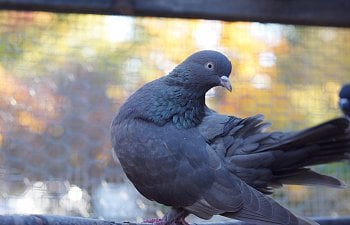Keeping Pigeons:
People keep pigeons for many different reasons such as racing/homing, breeding for shape and colors, fancy flying, pets or meat, so there are now hundreds of pigeon breeds bred for different uses and entertainment.
Food:
Everyone feeds their pigeons differently, so there is really no set diet but a mix of about 16% protein poultry pellets and some seeds and grains makes a good balanced diet. I feed my pigeons a variety of seeds and grains as well as poultry grower pellets (they don't need such high protein but I keep my quails with them and the quails need the extra protein in the grower pellets) and fresh greens and veggies. Some of their favorite foods are dry peas, such as maple peas and Canadian field peas, popcorn and whole dry corn, hulled barley, wheat and sunflower seeds. For veggies they will peck at - but not always eat as they can be picky about eating their vegetables - frozen defrosted peas, chopped up or shredded kale, lettuce, unsprayed dandelion greens and spinach. Sometimes I will sprout some seeds for them which they usually love, although a few take a little bit to get used to new foods. To sprout the seeds I let them soak in a jar with a screen on top overnight, then drain and leave upside-down rinsing every day until the sprouts are about the length of the seed. My pigeons prefer the sprouts to be less than a half inch at the most. Pigeons always need a source of grit and during breeding season a bowl of crushed oyster shell should be available at all times for the females.
Extra corn should be fed in the winter in cold climates because it helps them generate heat.
Water:
Pigeons always need access to clean drinking water and also love to bathe at least a couple times a week. The drinking water bowl should always be at least 1 inch deep because pigeons need to dip their whole beak in it to drink. The bath container should be at least a foot in diameter to fit one pigeon. They prefer to have a couple inches of water with a slightly grippy bottom so their feet don't slip and it should be cleaned after a day of bathing. They will all take turns bathing if the bath bowl only fits one or two pigeons at a time, and then sit with their wings spread out in the sun to dry.
Pigeons and doves produce a feather dust that keeps their feathers water-resistant and healthy but when they take a bath it leaves a white powdery layer on the surface of the water.
Housing:
My current pigeon cage started out as one 5' x 8' coop that I added on to as I got more pigeons. The middle section is only wire and they will sit in the sun after a bath to dry off. Also when it rains they love sitting outside in the rain "taking a shower" The cage is now about 8' x 13'.
Having the small cage in front is very useful for quarantining new birds or separating injured or fighting birds. I love building cages (that's why mine have so many sections added on afterwards) however cages do not need to be like this, an old garden shed or rabbit hutch will work fine for housing pigeons. Although not super important, they really love having a fully fenced-in outside area especially since I don't let mine free fly because of all the hawks in my area.
Nesting:
The picture on the right is of one of my hand-raised pigeons named Cranberry defending his nest from my hand. He and his mate usually prefer to nest on the ground so I let them incubate some quail eggs for me and removed them as soon as they hatched because the pigeons were freaking out about the little fuzzy quail chicks running around everywhere. Those quail were however the healthiest baby quail I have ever had so I think I'll let the pigeons hatch some more next spring.
Most pigeons prefer to use nesting boxes instead of just nesting on the ground although having the boxes this close together does not work very well for me because one pair will try to take control of all of the boxes. They should be at least a foot away from each-other.
Candling a pigeon egg after about 4 days of incubation shows the veins and embryo development.
The male will bring sticks to the nest and the female does the decorating.
Just-hatched baby pigeon under the mom. Pigeons feed their babies "crop milk" which is partially digested seeds and is high in protein and fat with lots of digestive enzymes that the babies need for the first few days of life. Once they are about 5 days old the parents start feeding them seeds mixed in with the crop milk, slowly increasing the amount of seeds/whole food until they are being fed only that. Once they are fully feathered and have left the nest they start eating on their own, but the male will usually still feed them for a couple more weeks until they are fully eating on their own. The female usually takes a break during this time or goes back to sitting on a new clutch of eggs.
Choosing Pigeons:
When purchasing pigeons you should choose ones that are alert and not too light or heavy, with clean eyes, nostrils, mouth/beak and feathers. New birds should always be quarantined for about 2-4 weeks before being introduced to any current birds to minimize risk of disease.


